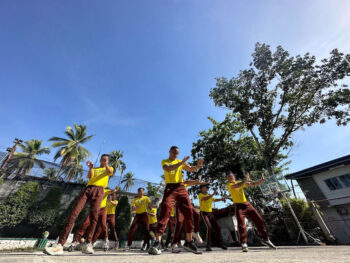GENERAL SANTOS CITY, May 5, 2015 – Last April 27, the Citizens’ Peace Council, with one of its convenors, former Chief Justice Hilario G. Davide Jr., reporting, told the House Ad Hoc Committee on Bangsamoro Basic Law (AHCBBL) that the proposed BBL “is compliant with the 1987 Constitution” and “the objection on the BBL because it will create a separate state has no basis” (GMA News, April 27, 2015: BBL complies with 1987 Constitution – peace council).
The Peace Council, in another GMA News report on the same day (Peace Council proposes minor changes to ‘unconstitutional’ clauses in draft BBL), “has proposed changes to certain provisions in the bill (HB 4994) that some lawmakers have deemed unconstitutional and want to delete”.
Yet, AHCBBL Chair Rep. Rufus Rodriguez “stood firm on the necessity of removing provisions in the measure providing for the creation of the Bangsamoro region’s own constitutional bodies” (GMA News, April 27, 2015: House panel head firm on unconstitutionality of some BBL provisions). However, he said AHCBLL would consider the Council’s recommendations” and majority decision of the 75 committee members will prevail over his position.
In The Philippine Star report (May 2, 2015: House panel rejects Bangsamoro expansion), by consensus among its members, AHCBBL “will adopt the recommendation of the citizen peace council to disallow a ‘creeping expansion’ of the Bangsamoro” – deleting the “opt-in” provision from the draft. This is encouraging but taken with reservation; the provision being among those earmarked by the Committee for deletion, the adoption does not necessarily mean deference to the Council.
If the House and the Senate defer to the recommendations of the Peace Council and adopt its proposed amendments and refinement of the provisions deemed unconstitutional and illegal, a meaningful BBL can be passed by June 11 and signed into law by the President. This can be submitted to a plebiscite by September so that it would not complicate the Commission on Elections’ preparation for the May 2016 presidential election.
The Council, in its reports, shows that Draft BBL is constitutional and legal. The Draft’s perceived infirmities must be cured through sober, judicious, objective and deliberate study of the issues, not to muddle these issues with anti-Moro biases and prejudices and not to aggravate the controversies with egotism so as to ultimately water down, mangle or scuttle the BBL; abort Bangsamoro; and imperil the peace process.
Citizens’ Peace Council
How reliable, responsible, authentic, authoritative and representative is the Council? What the Council is – what its vision and mission are and how it accomplished its task in two weeks – can be discerned from the Council’s Report and the five convenors’ letter “To the Filipino People”.
Composition: At the behest of the President last March 27 during the celebration of the first anniversary of the signing of the Comprehensive Agreement on the Bangsamoro, Manila Archbishop Luis Antonio Cardinal Tagle, former Chief Justice Hilario Davide, Jr, businessman Jaime Augusto Zobel de Ayala, former Philippine Ambassador to the Holy See and Malta Howard Dee, and founder of Teach Peace, Build Peace Movement, Bai Rohaniza Sumndad-Usman agreed to convene the Citizens’ Peace Council.
The five convenors of the Council, an independent body, invited 27 more co-convenors and held their first meeting on April 7. They formed four clusters — (1) Constitutionality and Forms and Powers of Government, chaired by Davide: (2) Economy and Patrimony, by Ayala; (3) Social Justice and Human Development, by Dee and Ms. Sumndad-Usman; and (4) Human Security (Peace and Order), by Retired General Alexander Aguirre and former Secretary Edilberto de Jesus.
Each cluster adopted its own processes and invited other participants and resource persons. During the discussion sessions more “came forward to contribute their collective knowledge, expertise, experience, and wisdom” — among them religious leaders, civil society representatives, members of the academe including deans of law schools, and businessmen.
By the full list of 136 members, the Council was composed of: three framers of the 1987 Constitution; two cardinals, four bishops including one from a Protestant Church, two priests, and one nun; three retired generals, two formerly involved in peace negotiations; six former cabinet members; and 95 others with 20 Muslim and IP leaders including a Timuay (IP spiritual leader) and 75 Christian leaders. Since IPs use Christian names, some names identified as “Christian” could be those of IPs.
Vision-Mission: The more than a century-old Moro Problem exploded into a rebellion in 1972. The peace process to end it started with the inclusion in the 1987 Constitution of provisions to establish regional autonomies for the Muslims and the Cordillera people. Aside, Sections 15 to 21 of Article X are essentially what Moro leaders asked for in their historic petitions and declarations in 1921, 1924, 1934 and 1935 and in the Tripoli Agreement of 1976 between the Government and the Moro National Liberation Front..
Draft BBL to be enacted into a law to establish Bangsamoro is the culmination of the peace process. The Congress had given the assurance to pass the proposed law (HB 4994 and SB 2408) by last March 17; however, the bloody encounter of the Police and the Moro rebels in Mamasapano, Maguindanao last January 25 derailed the legislative process. As the President lamented, it “created many doubts in the minds of Filipinos, and sidetracked the objective evaluation of the proposed Bangsamoro Basic Law (BBL)”.
The Peace Council was envisioned to independently scrutinize the proposed law to (1) temper the prevailing strong emotions of fear and distrust; (2) help clarify the many issues surrounding it; (3) understand its implications for peace and development in our country; (4) understand its provisions in the context of the history of the Moro insurgency; (5) and consider if it could effectively address the causes of the conflict.
Key Objectives
Zobel de Ayala explained the roles and key objectives of the Peace Council: first, assert citizens’ support for peace and development; second, affirm the validity of pursuing a law to govern with meaning and authority the autonomous Bangsamoro region; third, clarify contentious issues; and, fourth, ascertain the worthiness of BBL as the needed implementing legislation of the Comprehensive Agreement on the Bangsamoro.
Dee also explained the overarching goal is peace with justice and development in Muslim Mindanao with the aim to achieve in particular:
- A political peace settlement that addresses the injustices inflicted on the Bangsamoro religious, cultural and political identity as a people; they had their political identity before there was a Philippine nation;
- The human development of the Bangsamoro people by restoring their human rights and freedom to reverse their economic and social marginalization which has resulted in their human poverty level that is about twice the national average;
- A process of cultural and spiritual healing to overcome the deep-seated prejudices that continue to divide our people.
Deliberation
Over-arching Framework: The Cluster’s analysis of the BBL is premised on five interrelated propositions that serve as the over-arching framework for the Cluster’s task.
First, the passage of a law that creates an autonomous region is a constitutional mandate.
Second, the passage of an organic law for the autonomous region is compelled by the imperative of correcting the injustices of the past, the urgency of the socio-economic-political context at present, and the uncertainty of having a similar opportunity in the future.
Third, autonomy, especially in the context of the Constitution’s mandate for the creation of autonomous regions is, in itself, a peculiarity, and the region that is given autonomy must be recognized and respected for its uniqueness.
Fourth, the BBL must be understood as an extraordinarily special law, not only because of its nature as an organic act, but also, and more importantly, as an embodiment of a peace agreement, the product of prolonged negotiations.
Fifth, the Constitution must be interpreted liberally, so as to give life to its provisions, and allow the fulfilment of the decades-old mandate for genuine regional autonomy.
Deliberation Process: The Council “took time to learn from previous studies and from resource persons who presented views informed by years of studying and attempting to resolve the issues”. It “recognized some controversial aspects of the draft, but …S also shared the view that the legislation for autonomy requires a search for compromise and consensus. The entire process involved the free-wheeling exchange of ideas and views, asking hard questions, seeking clarification, engaging in debate and argumentation”.
General Conclusion
Evidently, from the congressional committee hearings and media reports, the Council compiled 20 sections including the “Preamble” deemed as unconstitutional, contrary to existing laws or unacceptable. The Council recommended the deletion of only one and suggested amendments or refinement for the 19 others.
[To Update: In today’s report of The Philippine Star (May 5, 2015: Congress eyes BBL passage in June), AHCBL Chair Rufus Rodriguez reiterated that the House has remained firm in its decision to delete at least eight unconstitutional provisions; Sen. Ferdinand R. Marcos, whose Senate Committee on Local Government has not finished conducting its BBL hearings, said there are 39 unconstitutional provisions.]
This is the general conclusion the Council has arrived at and is telling all, particularly, we suppose, the Congress: “Overall, we agreed that the BBL is overwhelmingly acceptable and deserves the support of all Filipinos. On the few provisions that needed some refinement, we offered recommendations.”
The five convenors closed their “Letter to the Filipino People” expressing hope, trust and faith:
“We express in the report our support to the passage of the BBL, together with our recommendations on a few provisions. We hope that Congress and our people can overcome their prejudices.
We cannot pursue peace on the basis of mutual fear and distrust. All of us must undertake an active search for justice, truth, respect, love and peace. We will exert all efforts in disseminating our findings, assuring everyone of the independence of the process.
“We do so with trust and faith that other citizens like us will decide that the BBL places peace within our grasp — peace for Mindanao and peace for all Filipinos.”
Crucial Question: How will the Congress respond?
(To Be Continued)
(Comment” is Mr. Patricio P. Diaz’ column for MindaViews, the opinion section of MindaNews. The Titus Brandsma Media Awards honored Mr. Diaz with a “Lifetime Achievement Award” for his “commitment to education and public information to Mindanawons as Journalist, Educator and Peace Advocate.” You can reach him at patponcediaz@yahoo.com)







